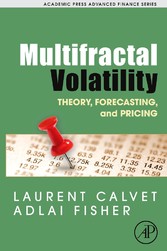Suchen und Finden
Service
Multifractal Volatility - Theory, Forecasting, and Pricing
Laurent E. Calvet, Adlai J. Fisher
Verlag Elsevier Reference Monographs, 2008
ISBN 9780080559964 , 272 Seiten
Format PDF
Kopierschutz DRM
Front Cover
1
Multifractal Volatility
4
Copyright Page
5
Table of Contents
6
Acknowledgments
10
Foreword
12
Credits and Copyright Exceptions
15
Chapter 1. Introduction
16
1.1 Empirical Properties of Financial Returns
16
1.2 Modeling Multifrequency Volatility
19
1.3 Pricing Multifrequency Risk
21
1.4 Contributions to Multifractal Literature
22
1.5 Organization of the Book
23
Part 1: Discrete Time
26
Chapter 2. Background: Discrete-Time Volatility Modeling
28
2.1 Autoregressive Volatility Modeling
28
2.2 Markov-Switching Models
31
Chapter 3. The Markov-Switching Multifractal (MSM) in Discrete Time
34
3.1 The MSM Model of Stochastic Volatility
35
3.1.1 Definition
35
3.1.2 Basic Properties
37
3.1.3 Low-Frequency Components and Long Memory
37
3.2 Maximum Likelihood Estimation
40
3.2.1 Updating the State Vector
40
3.2.2 Closed-Form Likelihood
41
3.3 Empirical Results
41
3.3.1 Currency Data
42
3.3.2 ML Estimation Results
42
3.3.3 Model Selection
47
3.4 Comparison with Alternative Models
49
3.4.1 In-Sample Comparison
50
3.4.2 Out-of-Sample Forecasts
50
3.4.3 Comparison with FIGARCH
57
3.5 Discussion
61
Chapter 4. Multivariate MSM
64
4.1 Comovement of Univariate Volatility Components
65
4.1.1 Comovement of Exchange Rate Volatility
65
4.1.2 Currency Volatility and Macroeconomic Indicators
70
4.2 A Bivariate Multifrequency Model
75
4.2.1 The Stochastic Volatility Specification
75
4.2.2 Properties
77
4.3 Inference
78
4.3.1 Closed-Form Likelihood
78
4.3.2 Particle Filter
78
4.3.3 Simulated Likelihood
79
4.3.4 Two-Step Estimation
81
4.4 Empirical Results
82
4.4.1 Bivariate MSM Estimates
82
4.4.2 Specification Tests
86
4.4.3 Out-of-Sample Diagnostics
88
4.4.4 Value-at-Risk
90
4.5 Discussion
92
Part 2: Continuous Time
94
Chapter 5. Background: Continuous-Time Volatility Modeling, Fractal Processes, and Multifractal Measures
96
5.1 Continuous-Time Models of Asset Prices
97
5.1.1 Brownian Motion, Time Deformation, and Jump-Diffusions
97
5.1.2 Self-Similar (Fractal) Processes
98
5.2 Multifractal Measures
99
5.2.1 The Binomial Measure
100
5.2.2 Random Multiplicative Cascades
101
5.2.3 Local Scales and the Multifractal Spectrum
104
5.2.4 The Spectrum of Multiplicative Measures
106
Chapter 6. Multifractal Diffusions Through Time Deformation and the MMAR
110
6.1 Multifractal Processes
110
6.2 Multifractal Time Deformation
111
6.3 The Multifractal Model of Asset Returns
113
6.3.1 Unconditional Distribution of Returns
113
6.3.2 Long Memory in Volatility
114
6.3.3 Sample Paths
115
6.4 An Extension with Autocorrelated Returns
116
6.5 Connection with Related Work
117
6.6 Discussion
118
Chapter 7. Continuous-Time MSM
120
7.1 MSM with Finitely Many Components
121
7.2 MSM with Countably Many Components
122
7.2.1 Limiting Time Deformation
122
7.2.2 Multifractal Price Diffusion
125
7.2.3 Connection between Discrete-Time and Continuous-Time Versions of MSM
126
7.3 MSM with Dependent Arrivals
129
7.4 Connection with Related Work
130
7.5 Discussion
134
Chapter 8. Power Variation
136
8.1 Power Variation in Currency Markets
136
8.1.1 Data
136
8.1.2 Methodology
138
8.1.3 Main Empirical Results
138
8.1.4 Comparison of MSM vs. Alternative Specifications
144
8.1.5 Global Tests of Fit
151
8.2 Power Variation in Equity Markets
152
8.3 Additional Moments
154
8.4 Discussion
156
Part III: Equilibrium Pricing
158
Chapter 9. Multifrequency News and Stock Returns
160
9.1 An Asset Pricing Model with Regime-Switching Dividends
162
9.1.1 Preferences, Consumption, and Dividends
163
9.1.2 Asset Pricing under Complete Information
164
9.2 Volatility Feedback with Multifrequency Shocks
166
9.2.1 Multifrequency Dividend News
166
9.2.2 Equilibrium Stock Returns
167
9.3 Empirical Results with Fully Informed Investors
168
9.3.1 Excess Return Data
168
9.3.2 Maximum Likelihood Estimation and Volatility Feedback
169
9.3.3 Comparison with Campbell and Hentschel (1992)
174
9.3.4 Conditional Inference
175
9.3.5 Return Decomposition
177
9.3.6 Alternative Calibrations
179
9.4 Learning about Volatility and Endogenous Skewness
180
9.4.1 Investor Information and Stock Returns
183
9.4.2 Learning Model Results
184
9.5 Preference Implications and Extension to Multifrequency Consumption Risk
187
9.6 Discussion
191
Chapter 10. Multifrequency Jump-Diffusions
192
10.1 An Equilibrium Model with Endogenous Price Jumps
193
10.1.1 Preferences, Information, and Income
193
10.1.2 Financial Markets and Equilibrium
194
10.1.3 Equilibrium Dynamics under Isoelastic Utility
196
10.2 A Multifrequency Jump-Diffusion for Equilibrium Stock Prices
198
10.2.1 Dividends with Multifrequency Volatility
198
10.2.2 Multifrequency Economies
198
10.2.3 The Equilibrium Stock Price
199
10.3 Price Dynamics with an Infinity of Frequencies
200
10.4 Recursive Utility and Priced Jumps
204
10.5 Discussion
206
Chapter 11. Conclusion
208
A. Appendices
212
A.1 Appendix to Chapter 3
212
A.1.1 Proof of Proposition 1
212
A.1.2 HAC-Adjusted Vuong Test
215
A.2 Appendix to Chapter 4
216
A.2.1 Distribution of the Arrival Vector
216
A.2.2 Ergodic Distribution of Volatility Components
216
A.2.3 Particle Filter
217
A.2.4 Two-Step Estimation
218
A.2.5 Value-at-Risk Forecasts
219
A.2.6 Extension to Many Assets
219
A.3 Appendix to Chapter 5
222
A.3.1 Properties of D
222
A.3.2 Interpretation of f(a) as a Fractal Dimension
222
A.3.3 Heuristic Proof of Proposition 3
223
A.4 Appendix to Chapter 6
224
A.4.1 Concavity of the Scaling Function t (q)
224
A.4.2 Proof of Proposition 5
224
A.4.3 Proof of Proposition 7
225
A.4.4 Proof of Proposition 8
225
A.5 Appendix to Chapter 7
226
A.5.1 Multivariate Version of Continuous-Time MSM
226
A.5.2 Proof of Proposition 9
227
A.5.3 Proof of Proposition 10
229
A.5.4 Proof of Corollary 1
231
A.5.5 Proof of Proposition 11
231
A.5.6 MSM with Dependent Arrivals
233
A.5.7 Autocovariogram of Log Volatility in MSM
234
A.5.8 Limiting MRW Process
234
A.6 Appendix to Chapter 9
235
A.6.1 Full-Information Economies
235
A.6.2 Learning Economies
238
A.6.3 Multifrequency Consumption Risk
239
A.7 Appendix to Chapter 10
239
A.7.1 Proof of Proposition 13
239
A.7.2 Multivariate Extensions
240
A.7.3 Proof of Proposition 14
241
A.7.4 Proof of Proposition 15
242
References
244
Index
266



